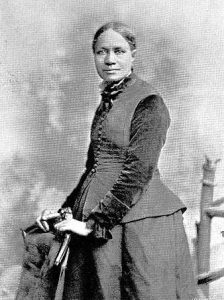105
 Frances Ellen Watkins was born on September 24th 1825 in Baltimore, Maryland. She was born into a free African-American family. After her parents died at a young age, she was then raised by her maternal aunt and uncle. Her uncle Reverend William Watkins was a civil rights activist. Harper studied in his “Academy for Negro Youth” until she was 13 years old. After leaving the academy, she started to work with a white family as their domestic worker. Despite the fact that during this time, Harper didn’t get any formal education she still had access to several literary pieces in her employee’s house. Interestingly, it was also during this time period that Harper began writing poetry. Her fist collection “Forest Leaves”, was published in 1845 when she was just 20 years old. Five years later, she moved to Ohio where where she became the first female teacher at the Union Seminary, a school run by John Brown. While Harper was teaching in Ohio, the state of Maryland passed a law that allowed free blacks to be arrested and sold into slavery. Being Harper’s home state, it was in 1953 that she decided to join the American Anti-Slavery Society. After two years teaching, she became a speaker against slavery and she started to travel all over the country to support the abolitionist movement. In 1854, “Poems of Miscellaneous Subjects” which included one of her most famous poems “Bury Me in a Free Land” was published. A few years later, Harper made history again with her text “Two Offers”, becoming the first African-American female to publish a short story. In 1860, Frances married Fenton Harper and they settle in Ohio. Fenton had three kids of his own and together they had a daughter. Fenton died in 1864, which meant Harper’s main focus then became supporting her family. Nevertheless, she continued supporting the abolitionist movement, women’s rights and education opportunities. Harper attained many accolades during her time as a writer. She became the co-founder and Vice President of the National Association of Colored Women as well as a member of the American Women’s Suffrage Association and director of the American Association of Colored Youth. As the years went by her health decreased, Harper’s involvement in all these movements lessened. Eventually she died of heart failure on February 22, 1911 in Philadelphia, Pennsylvania.
Frances Ellen Watkins was born on September 24th 1825 in Baltimore, Maryland. She was born into a free African-American family. After her parents died at a young age, she was then raised by her maternal aunt and uncle. Her uncle Reverend William Watkins was a civil rights activist. Harper studied in his “Academy for Negro Youth” until she was 13 years old. After leaving the academy, she started to work with a white family as their domestic worker. Despite the fact that during this time, Harper didn’t get any formal education she still had access to several literary pieces in her employee’s house. Interestingly, it was also during this time period that Harper began writing poetry. Her fist collection “Forest Leaves”, was published in 1845 when she was just 20 years old. Five years later, she moved to Ohio where where she became the first female teacher at the Union Seminary, a school run by John Brown. While Harper was teaching in Ohio, the state of Maryland passed a law that allowed free blacks to be arrested and sold into slavery. Being Harper’s home state, it was in 1953 that she decided to join the American Anti-Slavery Society. After two years teaching, she became a speaker against slavery and she started to travel all over the country to support the abolitionist movement. In 1854, “Poems of Miscellaneous Subjects” which included one of her most famous poems “Bury Me in a Free Land” was published. A few years later, Harper made history again with her text “Two Offers”, becoming the first African-American female to publish a short story. In 1860, Frances married Fenton Harper and they settle in Ohio. Fenton had three kids of his own and together they had a daughter. Fenton died in 1864, which meant Harper’s main focus then became supporting her family. Nevertheless, she continued supporting the abolitionist movement, women’s rights and education opportunities. Harper attained many accolades during her time as a writer. She became the co-founder and Vice President of the National Association of Colored Women as well as a member of the American Women’s Suffrage Association and director of the American Association of Colored Youth. As the years went by her health decreased, Harper’s involvement in all these movements lessened. Eventually she died of heart failure on February 22, 1911 in Philadelphia, Pennsylvania.
Sources
www.poetryfoundation.org/poems-and-poets/poets/detail/frances-ellen-watkins-harper
en.m.wikipedia.org/wiki/Frances_Harper
www.biography.com/people/frances-ew-harper-40710
Media Attributions
- 36268098-aad6-4fdd-ab08-08ffb9668acf-2174-000002e5791f5afe_tmp
